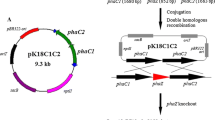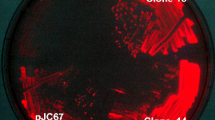Abstract
We have studied the accumulation kinetics and physical characteristics of the poly(3-hydroxyalkanoates) (PHAs) formed by several Pseudomonas strains, mutants and recombinants. Although PHA synthesis generally begins only after an essential nutrient such as N, P, S or Mg becomes limiting, we have identified at least one strain (P. putida KT2442) that begins producing PHA during the exponential growth phase. This PHA is chemically and physically identical to that produced by P. oleovorans GPol, the strain in which we first identified PHA. Analysis of the PHA formed by a mutant strain defective in PHA degradation (P. oleovorans GPo500) revealed that the molecular mass (Mw), the monomer composition and thermal characteristics were similar to that of the PHA of the wild-type parent strain P. oleovorans GPo1. The pha locus of P. oleovorans encodes enzymes that are involved in PHA biosynthesis and degradation. It has been subcloned to study the two PHA polymerases separately in a PHA− mutant (GPp104) derived from P. putida KT2442. The recombinant strains accumulated lower PHA levels than the wild-type strains, and the Mw of these polymers were lower than those produced by the wild-type P. oleovorans and parent strain. The monomer composition of the two PHAs formed by the two PHA polymerases differed, indicating that the PHA polymerases have different substrate specificities for the incorporation of 3-hydroxyoctanoate and 3-hydroxyhexanoate monomers into PHA. Despite these differences, the PHAs formed were essentially indistinguishable from wild-type PHAs with respect to their thermal characteristics.
Similar content being viewed by others
References
Brandl H, Gross RA, Lenz RW, Fuller RC (1988) Pseudomonas oleovorans as a source of poly(3-hydroxyalkanoates) for potential application as biodegradable polyesters. Appl Environ Microbiol 54:1977–1982
Braunegg G, Bogensberger B (1985) Zur Kinetik des Wachastums und der Speicherung von Poly-d(−)-3-hydroxybuttersäure bei Alcaligenes latus. Acta Biotechnol 5:339–345
Byrom D (1987) Polymer synthesis by microorganisms: technology and economics. Tibtech 5:246–250
Davidson J, Heusterpreute M, Chevalier N, Ha-Thi V, Brunel F (1987) Vectors with restriction site banks, V. pJRD215, a wide host range cosmid vector with multiple cloning sites. Gene 51:275–280
Ditta G, Stanfield S, Corbin D, Helinski DR (1980) Broad host range DNA cloning system for gram-negative bacteria: construction of a gene bank of Rhizobium meliloti. Proc Natl Acad Sci USA 77:7347–7351
Doi Y, Segawa A, Kawaguchi Y, Kunioka M (1990) Cyclic nature of poly(3-hydroxyalkanoate) metabolism in Alcaligenes eutrophus. FEMS Microbiol Lett 67:165–170
Franklin FCH, Bagdasarian M, Bagdasarian MM, Timmis KN (1981) Molecular and functional analysis of the TOL plasmid pWWO from Pseudomonas putida and cloning of genes for the entire regulated aromatic ring meta cleavage pathway. Proc Natl Acad Sci USA 78:7458–7462
Gross RA, DeMello C, Lenz RW, Brandl H, Fuller RC (1989) Biosynthesis and characterization of poly(β-hydroxyalkanoates) produced by Pseudomonas oleovorans. Macromolecules 22:1106–1115
Grund A, Shapiro J, Fennewald M, Bacha P, Leahy J, Markbreiter K, Nieder M, Toepfer M (1975) Regulation of alkane oxidation in Pseudomonas putida. J Bacteriol 123:546–556
Haywood GW, Anderson AJ, Dawes EA (1989) A survey of the accumulation of novel polyhydroxyalkanoates by bacteria. Biotechnol Lett 11:471–476
Huisman GW, Leeuw O de, Eggink G, Witholt B (1989) Synthesis of poly(3-hydroxyalkanoates) is a common feature of fluorescent pseudomonads. Appl Environ Microbiol 55:1949–1954
Huisman GW, Wonink E, Meina R, Kazemier B, Terpstra P, Witholt B (1991) Metabolism of poly β-hydroxyalkanoates by Pseudomonas oleovorans: identification and sequences of genes and function of the encoded proteins in the synthesis and degradation of PHA. J Biol Chem 266:2191–2198
Lageveen RG, Huisman GW, Preusting H, Ketelaar P, Eggink G, Witholt B (1988) Formation of polyesters by Pseudomonas oleovorans: effect of substrates on formation and composition of poly-(R)-3-hydroxyalkanoates and poly-(R)-3-hydroxyalkenoates. Appl Environ Microbiol 54:2924–2932
Page WJ (1989) Production of poly-β-hydroxybutyrate by Azotobacter vinelandii strain UWD during growth on molasses and other complex carbon sources. Appl Microbiol Biotechnol 31:329–333
Page WJ, Knosp O (1989) Hyperproduction of poly-β-hydroxybutyrate during exponential growth of Azotobacter vinelandii UWD. Appl Environ Microbiol 55:1334–1339
Pool R (1989) In search of the plastic potato. Science 245:1187–1189
Preusting H, Nijenhuis A, Witholt B (1990) Physical characteristics of poly(3-hydroxyalkanoates) and poly(3-hydroxyalkanoates) produced by Pseudomonas oleovorans grown on alipathic hydrocarbons. Macromolecules 23:4220–4224
Schwartz RD, McCoy CJ (1973) Pseudomonas oleovorans hydroxylation-epoxidation system: additional strain improvements. Appl Microbiol 26:217–218
Smet MJ de, Eggink G, Witholt B, Kingma J, Wijnberg H (1983) Characterization of intracellular inclusions formed by Pseudomonas oleovorans during growth on octane. J Bacteriol 154:870–878
Stanier RY, Palleroni NJ, Doudoroff M (1966) The aerobic pseudomonas: a taxonomic study. J Gen Microbiol 43:159–271
Vogel HJ, Bonner DM (1956) Acetylornithinase of Escherichia coli: partial purification and some properties. J Biol Chem 218:97–106
Witholt B (1972) Method for isolating mutants overproducing nicotinamide adenine dinucleotide and its precursors. J Bacteriol 109:350–364
Author information
Authors and Affiliations
Additional information
Correspondence to: B. Witholt
Rights and permissions
About this article
Cite this article
Huisman, G.W., Wonink, E., de Koning, G. et al. Synthesis of poly(3-hydroxyalkanoates) by mutant and recombinant Pseudomonas strains. Appl Microbiol Biotechnol 38, 1–5 (1992). https://doi.org/10.1007/BF00169409
Received:
Accepted:
Issue Date:
DOI: https://doi.org/10.1007/BF00169409




